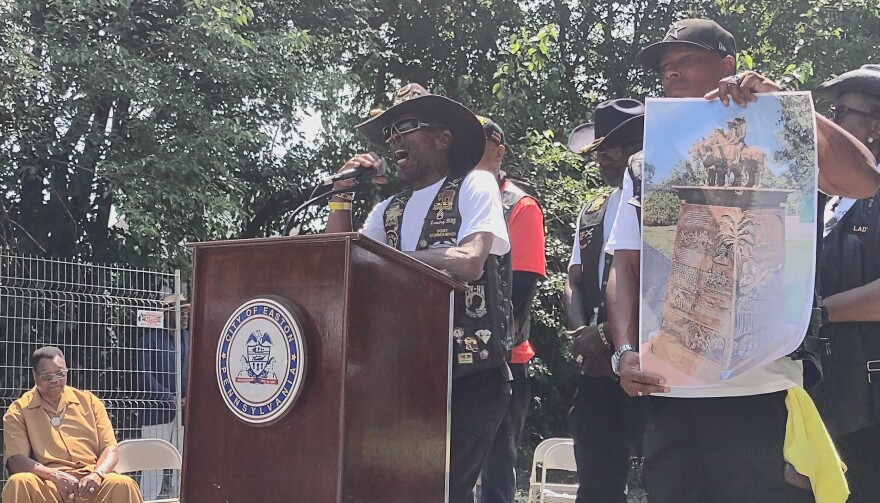EASTON, Pa. — For about 20 years, Carol Hanlon tried to draw attention to Nesquehoning Street Park.
While many were upset about the basketball court's cracked pavement and the poor upkeep, Hanlon said she tried to raise awareness about the secret that lay beneath.
On Saturday, standing beside members of the Lehigh Valley Buffalo Soldiers motorcycle club, she quietly sang along as a bugler played the national anthem at a ceremony recognizing the First Colored Lutheran Church Cemetery, or FLCL. Last year, sub-surface radar tests proved what she had long known — that the pocket park had been built over the bones of African Americans residents.
"Sometimes, it's almost overwhelming,"Carol Hanlon
"Sometimes, it's almost overwhelming," Hanlon said following the ceremony, saying she felt at peace.
She was one of about 100 city leaders, neighbors, media, veterans and family of the deceased who gathered in the shade of the park to pay their respects.
An honor guard fired a 21-gun salute, and John Pitts, post commander of the Lehigh Valley Buffalo Soldiers, laid a wreath on the park's fence.
"We put this together because we didn't want to leave the community behind," Pitts said. "This is a Lehigh Valley project. We want the Lehigh Valley to see exactly what went on here."
For about three years, city officials, consultants, veterans and local volunteers have peeled away layers of history to uncover the story of the cemetery. Experts believe about nine people are buried under the park itself and that dozens more rest in the surrounding residential properties that have sprung up over the past 160 years.
"We put this together because we didn't want to leave the community behind, this is a Lehigh Valley project. We want the Lehigh Valley to see exactly what went on here."John Pitts
Pitts believes nine of the people laid to rest at FCLC were Buffalo Soldiers, members of all-Black cavalry and infantry units that operated from 1866 until the end of the Korean War. The motorcycle club, comprised of veterans that seek to honor their military forefathers, helped press the matter and worked with the city to ensure proper respects would be paid.
He, Councilman Ken Brown, local volunteers and members of other Buffalo Soldier chapters from as far away as Pittsburgh spent months cross-referencing military documents and burial records to learn everything they could about the cemetery, especially the deceased Buffalo Soldiers. Pitt credited people like Hanlon who presented the group with the information they needed to bring about change.
The committee has presented City Council with two proposals for a memorial at the park. Mayor Sal Panto expected officials to select one in the next 30 days. An old basketball court on the site has already been removed.
Righting wrongs
Panto, who said he played at the park's basketball court as a child, said the city was righting a wrong by moving forward with the memorial. The discovery of the cemetery showed Easton fit into the wider story of America, where a diverse array of people have long lived together — for good and for ill.
"We don't know how they passed. We only know the heartbreaking story of how history has treated them — very poorly,"Sal Panto Jr.
"We don't know how they passed. We only know the heartbreaking story of how history has treated them — very poorly," Panto said of FCLC's dead. "It's a work of compassion to give some dignity to those buried here; both those we know and those we don't know."
But some tensions strained beneath the ceremony's somber mood.
Pitt said the committee relied on the genealogy skills of Ashley Woolley, who helped identify many of those buried under the park and on surrounding properties. Her five-times-great-grandfather Aaron Hoff helped found the First Colored Lutheran Church. She estimated that about half the 43 people buried in its cemetery are her relatives.
Hoff, the first African American student to attend Lafayette College, died in 1902 and was buried in the cemetery before being exhumed and reinterred at Easton Cemetery back in the 1990s, she said. Students at Lafayette College raised funds to provide a marker at his new grave site.
But how could the city claim that it didn't know of the cemetery when bodies were removed from the site 30 years ago? Woolley doesn't intend to let that question remain unanswered. Somewhere in decades-old city records, Woolley expects to find documentation that will spell out who gave the go ahead to pave over her family.
"They removed the headstones. They knew this was a burial ground," she said.


